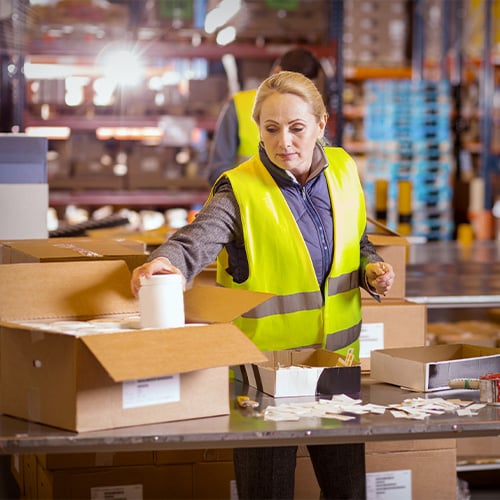
A warehouse packing station consolidates the fulfillment process into a single location, simplifying the procedure and making it more manageable for employees. Whether you're just starting a warehouse or looking to improve the efficiency of an already-existing industrial location, adding a packing station will increase the speed at which your orders are shipped. Below we outline how to establish your own warehouse packing station as well as how packing stations help eliminate shipping errors and improve overall shipping quality.
Shop All Industrial Packing TablesPacking In Warehouse

The packing process involves preparing inventory for shipment after it has been picked for an order. There are several steps in the packing process, as items need to be protected and labeled. Below, we’ve outlined the typical warehouse packing process and the common steps that occur at warehouse packing stations:
- Printing - The first step of the packing process is printing the shipping label that lists all the items that need to be packed.
- Wrapping - Next, items are wrapped in protective packaging to ensure no damage occurs during transit.
- Boxing - Items are then packaged in shipping boxes, adding an extra layer of protection and making them easier to ship.
- Labeling - To finish, shipping labels are attached to the items’ boxes, readying the items for shipment.
What Is a Packing Station?
A warehouse packing station is a designated area where items are packed for shipping. At a packing station, goods are checked, packed, and labeled before being shipped to customers. Quality warehouse packing stations can provide a huge boost to your order fulfillment process, allowing staff to quickly check that orders are packed and labeled correctly. Packing stations not only expedite the shipping process but also ensure that mistakes during the packing and shipping process are limited.
What Is Pick and Pack?
Pick and pack is a common order fulfillment system utilized by shipping warehouses. The procedure involves workers picking orders direct from warehouse shelves and packing them into small individual orders. Efficiency and organization are required for a warehouse to utilize a pick-and-pack fulfillment system, making quality warehouse packing stations vital in these environments.
Warehouse Packing Station Layout
The most important factors in a successful warehouse packing station are its layout and design. In order to maximize your packing station’s efficiency and effectiveness, you need to design it in a way that staff can fill orders fast. This layout should be tailored to your warehouse's specifics, allowing staff to pack and ship goods in a quick and easy manner.
1. Products
One of the most important things to consider when constructing your packing station layout is the type of items that are being packed. Some warehouses may ship heavy items that require strong and durable workbenches, while others may ship products such as baked goods that require specific packaging to be stored nearby. You want to design your packing station with your product selection in mind, ensuring it is built to the specifications required by the items you ship. Failing to consider the types of items packed and shipped can lead to accidents, disrupting workflow and endangering workers.

2. Equipment
The equipment required to pack and ship the items in your warehouse is another important consideration to take in when designing your packing station layout. Will your station need a designated area for large shipping boxes? Are there important electronic devices that need to be set up and installed in the packing station? Before finalizing a layout, ensure you know what type of equipment your station needs to be outfitted with.
3. Ergonomics
When creating your packing station layout, consider the ergonomics of the station for your staff. Small ergonomic additions such as comfortable seating and adjustable workbench heights do a great deal in lessening the strain on employees and reducing the risk of injury. Warehouse jobs can be demanding, so it’s important to make working conditions as ergonomic as possible. Doing so helps improve morale and allows your workers to be more productive.
Organizing Shipping Supplies
In order to get the most out of your packing station, you need to organize your shipping supplies. Organized shipping supplies make it easy for employees to check, pack, and label items with minimal errors. Here are some of the most common tools you can outfit your warehouse packing station with to organize shipping supplies and improve the overall efficiency of your station:
- Roll Holders - Roll holders allow staff to access shipping equipment like packaging paper with ease.
- Label Printers - Print out and organize shipping labels with label printers.
- Monitor Mount - Monitor mounts ensure that devices like laptops and tablets are accessible for packers, allowing staff to scan items.
- Tool Holder - Place equipment like tape guns and product scanners in a convenient location with tool holders.
Packing Station Design
Packing station design varies in different locations due to the types of items being packed. Some items might have features that require specific equipment, while other items may be larger and require a bigger space. With that in mind, there are a few elements of a packing station you’ll have to include regardless of what type of warehouse you operate. Here are some of the most important packing station design aspects to consider:

- Workbench - Workbenches are the most important part of your packing station design because it is where the majority of packing and labeling will occur. Packing station workbenches need to be large and durable, providing workers with enough space to pack.
- Shelves - Supplies and equipment can be stored on shelves attached to the workbench, allowing workers to access them with ease.
- Uprights - Workbench uprights are a great ergonomic option that allows for easy attachment of workbench accessories.
- Lighting - Proper warehouse lighting around packing stations is important. Workers need visibility of their surroundings when packaging shipments, and proper lighting helps cut down on mistakes.
Packing Station Benefits
A well-designed packing station improves the efficiency of your warehouse and makes tasks easier for your warehouse staff. Not only can these stations improve the quality of your warehouse shipping, but they also can make jobs safer and easier for your employees. Here are some of the most commonly cited advantages of having a packing station in your warehouse:

- Increased Productivity - Establishing a packing station improves workflow patterns, allowing workers to be more productive and complete tasks more efficiently.
- Organization - Anchoring shipping supplies in one location will make tracking and monitoring shipments and their contents easy.
- Ergonomics - Packing stations can be optimized to minimize strain on workers packing products, lowering the risk of injury and improving overall warehouse safety.
- Cost-effective - Warehouse packing stations allow you to expand your shipping operations, allowing your warehouse to package a large number of products effectively.
In today’s business climate, shipping online orders is a vital part of the success of a business. Warehouse packing stations have a lot of value in industrial settings, enhancing your order fulfillment process. By consolidating your shipping materials and equipment into one location, it is much easier for employees to pick and pack orders quickly. The end result is an expedited shipping process that allows your warehouse to ship items out to customers on time.





